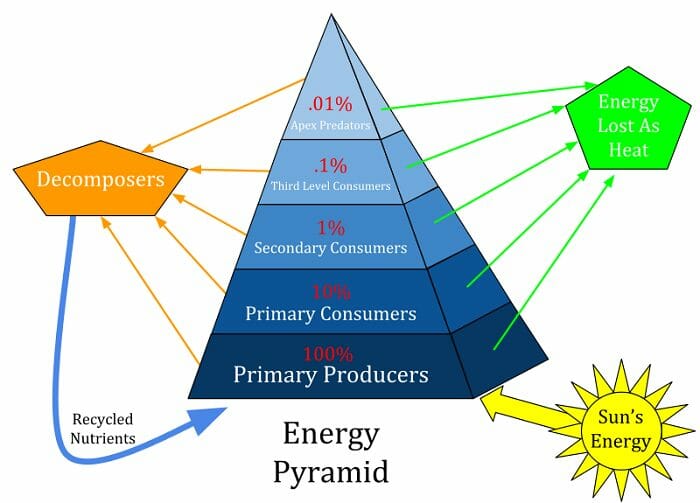Energy Pyramid Definition
An energy pyramid (sometimes called a trophic pyramid or an ecological pyramid) is a graphical representation, showing the flow of energy at each trophic level in an ecosystem.
The width of each bar represents the units of energy available within each trophic level; the height is always the same. The flow of energy moves through the layers of the energy pyramid from the bottom-up, and is gradually reduced as energy is used up by the organisms at each level
The base of the energy pyramid indicates the energy available within primary producers. Primary producers, also known as autotrophs, are organisms which create their own food by taking their energy from non-living sources of energy. In most cases, these are photosynthesizing plants, which use energy from the sun to create their own nutrition in the form of simple sugars, although there are exceptions such as deep sea organisms, which use chemical energy from hydrothermal vents. In this description we will focus on ecosystems that take energy from the sun.
All other levels in the energy pyramid consist of heterotrophs – organisms that obtain their nutrition from organic carbon, usually in the form of other plants and animals.
The second trophic level consists of primary consumers. These are the herbivores that feed solely on primary producers. The third and fourth levels are made up of secondary consumers and tertiary consumers. These are carnivores and omnivores, which can feed on any of the lower levels, although mainly consume organisms from the trophic level directly beneath them. The top layer of the energy pyramid contains apex predators. These are mostly carnivorous animals that have no natural predators.
The pyramid shape is used to represent the flow of energy because of the way that energy is used up and lost throughout the system.
The primary producers take in energy from the sun. However, only around 1% of the total available sun energy is actually absorbed into the plants (it can move through, or bounce off, the plants); this is the GPP or the Gross Primary Productivity. Fortunately, such a high amount of energy is emitted from the sun, that 1% is sufficient to support plants; in areas of high energy input from the sun, e.g., tropical biomes, the GPP is higher than in those areas where energy input from the sun is low.
Plants use photosynthesis in order to convert energy from the sun into chemical energy, which is stored as organic compounds such as sugars. The plants then carry out cell respirationin order to convert the sugars into the useable energy molecule ATP (adenosine triphosphate). Cell respiration is a metabolic reaction which uses up around 60% of the plant’s energy, leaving around 40% of the GPP as the NPP, or Net Primary Productivity. This NPP value represents 100% of the total energy units made available for the plants to use.
Energy is used up for all life processes such as respiration, movement, metabolic processes, and reproduction. So, of the 100% total energy available to the plants, only around 10% is made into plant tissues, while 90% is used up and is lost as heat.
At each of the subsequent trophic levels, the same amount of energy (90%) is lost as heat, while 10% is turned into available biomatter. By the time the energy reaches the top trophic level, the apex predators will only receive 0.01% of the primary energy! Because there is so little energy available at the highest trophic level, food chains are typically limited to a maximum of six levels.
Throughout the entire energy pyramid, decomposers and detritavores break down the tissues and other organic matter which has not been consumed by animals higher in the food chain. In doing so, these organisms recycle the nutrients back into the soil, playing a vitally important role in the carbon and nitrogen cycles.
Related Biology Terms
- Trophic Level – Each of the hierarchal levels in an ecosystem, in which organisms share the same function and nutritional relationship within the food chain.
- Food Web – The biological community in which organisms interact with each other and their physical environment.
- Autotroph – An organism which is able to produce its own nutrition in the form of organic substances from inorganic substances such as carbon dioxide.
- Heterotroph – An organism which must derive its nutrition from organic substances, usually plant and animal matter.
Quiz
1. An energy pyramid is a graphical representation of:
A. The number of animals in an ecosystem
B. The flow of energy through each trophic level
C. The number of animals at each trophic level
D. The amount of biomass in an individual animal
2. What percentage of the energy created by primary producers is available to secondary consumers?
A. 10%
B. 9%
C. 30%
D. 1%
3. What is the Net Primary Productivity?
A. The amount of energy that is emitted by the sun
B. The amount of energy available in primary producers after cell respiration
C. The amount of energy at the top level of an energy pyramid
D. The amount of energy stored within primary producers before cell respiration

